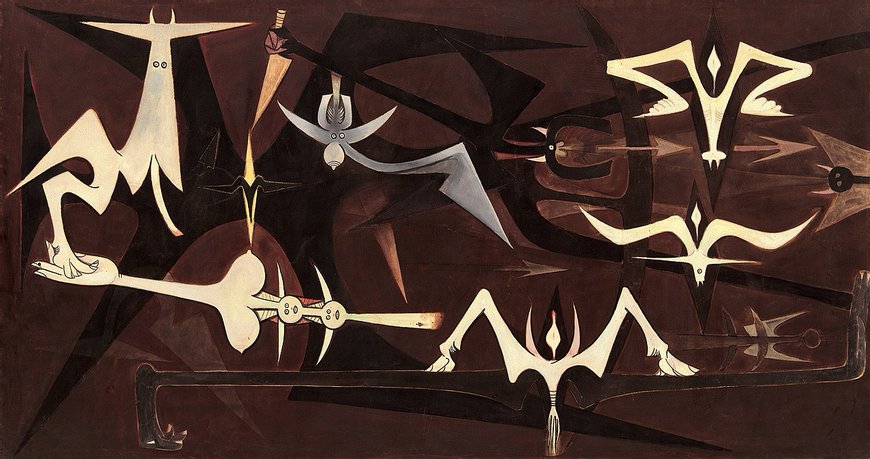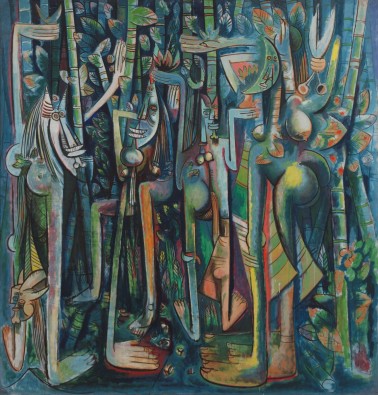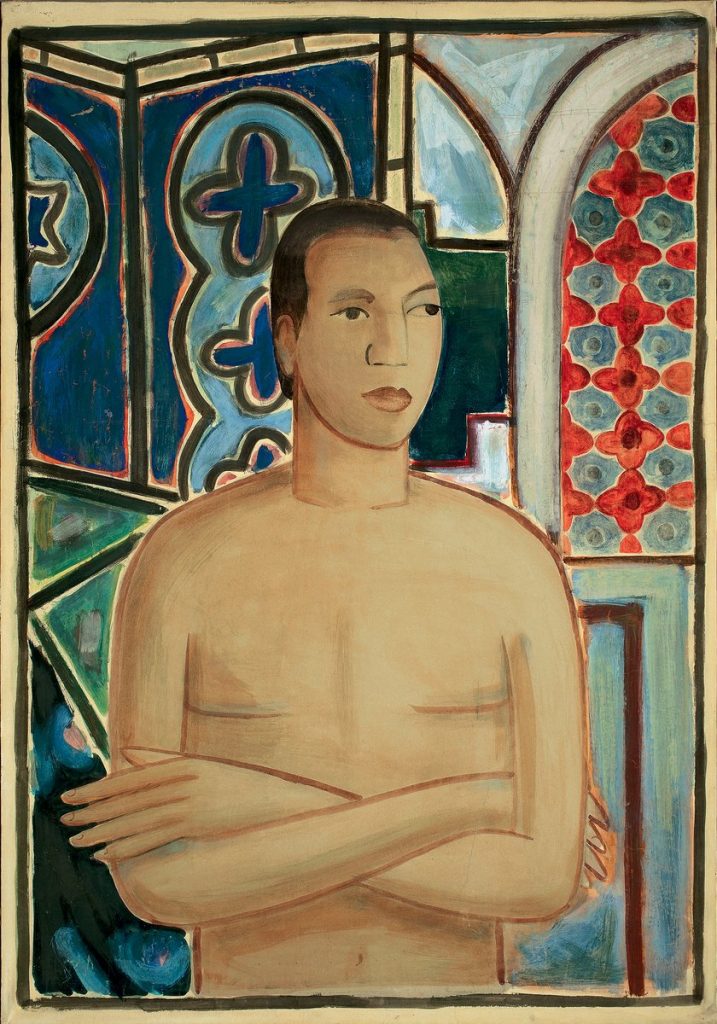
Introduction
Wifredo Óscar de la Concepción Lam y Castilla, better known as Wifredo Lam was a Cuban artist who sought out to portray and revive the Afro-Cuban spirt and culture through his paintings and other art forms. Along with his childhood and life experiences, as Lam traveled throughout the world, he picked up different inspirations, influences, and techniques, that eventually shaped him as an artist. This is specifically seen when comparing his early works, which for the most part where in the modernist Spanish tradition, to his life later on when he becomes heavily influenced by surrealism and cubism.
Throughout his travels in Spain, Lam developed an empathy for Spanish peasants that reminded him of the slaves he grew up around in Cuba. This was reflected in many of his arts works and after his son died of tuberculosis, Lam’s artwork took on a darker nature. Due to the spanish Civil war in 1937, Lam was forced to more to Barcelona where he met Manolo Hugue who introduced him to Picasso. After moving to Paris and gain support from Picasso and some of his colleagues, Lam’s work went from showing influences of surrealism and Henry Matisse to being heavily influenced by Cubism.
Lam’s life experiences, travels and relationships built him as an artist. As someone who didn’t like academic teaching and painting, his technical developments can be attributed to his time spent in Europe, learning and being influenced by other great artists. Lam is very open about the significant impact Picasso had on him and his artwork. He often stated that his approval from Picasso allowed and encouraged him to find his own interpretation of modernism where he could dramatically synthesize Surrealist and Cubist strategies to represent his Afro-Cuban culture.
Childhood Muses
“The luxuriant nature of Sagua la Grande had a strong impact on Lam from early childhood. One night in 1907, he was startled by the strange shadows cast on the wall of his bedroom of a bat in flight. He often recounted the incident as his first magnificent awakening to another dimension to existence.”
wilfredolam.net
Lam used the childhood perspectives of his past to influence the art he knew his audience could connect to. While composing pieces of complexity in physical presentation, the conceptual presentation of his work was that of simplistic beauty.
Life Timeline
1902- Born in La Sagua La Grande, Villa la Clara, Cuba
1916- Attended Escuela de Bellas Artes, Havana, Cuba
1920–1923- Attended the Acadamia San Atejandra, Havana, Cuba
1923- Moved to Madrid, Spain
1924–1928- Free Academy, Madrid, Spain
1938- Moved to Paris, France, and became associated with the Surrealists
1939- Worked with Picasso, France
1940- Goes to Marseilles where he tries to join in fleeing France and WWII
1940- Lam’s Composition (The Three Oranges)
1941- Moved back to Cuba
1943- La Jungla composition; largely influenced by Afro-Cuban works. His most well-known composition.
1944- Marries his wife, Helena
1944- New York exhibition of La Jungla; later purchased by the MOMA
1946- In January begins his exhibitions in Port-au-Prince at the Centre d’art; his exhibition is extremely successful
1946- Moves back to Paris, France
1951- Received First Prize at the Salone Nacionale in Havana, Cuba
1953- Received the Gold Medal for foreign painters in Premlo Lissone, Rome, Italy
1958- Named a member of the Graham Foundation for Advanced Study in Fine Art, Chicago, IL
1964- Awarded the Guggenheim International Award, New York, NY
1965- Received the Premio Marzotto in Milan, Italy
1982- Died in Paris, France
Exhibitions
1982- Pierre Matisse Gallery, New York, NY (solo)
1979- Artcurial, Paris, France (solo)
1972- Galerie Tronche, Paris, France (solo)
1971- Galerie Gimpel und Hanover, Zurich, Switzerland (solo)
1970- Galleria Arte Borgogna, Milan, Italy (solo)
Gimpel and Weitzenhoffer, New York, NY (solo)
1969- Galleria Bergarnini, Milan, Italy (solo)
1968- Galerie Villand et Galanis, Paris, France (solo)
1967- Stedelijk Museum, Amsterdam, The Netherlands (solo)
1966- Kestner-Gesellschaft, Hannover, Germany (solo)
Musee d’Art Moderne de Ia Ville, Paris, France
1965- Museo de Arte Moderna, Havana, Cuba (solo)
Galerie Anderson, Malmo, Sweden (solo)
1964- Galleria Notizie, Turin, Italy (solo)1963Galerie Krugier, Geneva, Switzerland (solo)
Galeria de la flabana, Havana, Cuba (solo)
1962- Salone Annunciata, Milan, Italy (solo)
1961- Galerie La Cour d’Ingres, Paris, France (solo)
Galleria del Canale, Venice, Italy (solo)
Galleria del Obelisco, Rome, Italy (solo)
Albert Loeb Gallery, New York, NY (solo)
1959- Galleria Grattacielo, Milan, Italy (solo)
1957- Palacio de Bellas Artes, Marcaibo, Venezuela (solo)
Galerie Cahiers d’Art, Paris, France (solo)
1955- Galerie Colibri, Malmo, Sweden (solo)
University of Havana, Havana, Cuba (solo)
Museo de Deltas Artes, Caracas, Venezuela (solo)
1953- Galerie Maeght, Paris, France (solo)1952Institute of contemporary Arts, London, UK (solo)
1951- Ministry of Education, Havana, Cuba (solo)
1950- Lam: Obras Recientes 1950, Parque Central, Havana, Cuba (solo)
Pierre Matisse Gallery, New York, NY (solo)
1948- Pierre Matisse Gallery, New York, NY (solo)
1946- The Cuban Painter Wifredo Lam, The London Gallery, London, UK (solo)
Centre d’Art, Port-an-Prince, Haiti (solo)
1945- Wifredo Lam, Galerie Pierre, Paris, France (solo)
1944–1945- Lam Paintings, Pierre Matisse Gallery, New York, NY (solo)
1942- Pierre Matisse Gallery, New York, NY (solo)
1939- Wifredo Lam Peintures, Galerie Pierre, Paris, France (solo)
Drawings by Picasso and Gouaches by Wifredo Lam, Perls Gallery, New York, NY
1928- GalerieVilches, Madrid, Spain (solo)
Biography
On December eighth, 1902 Wifredo Lam was brought into the world in Sagua la Grande, Cuba. He was the eighth kid destined to Lam-Yam. The rich idea of Sagua la Grande strongly affected Lam from youth. He is known for his association of pioneer feel and Afro-Cuban imagery. Lam was destined to a Chinese laborer father and a mother of African and Spanish fall. He got out the little town of Sagua la Grande for Havana in 1916, where he from the outset thought about law. By 1918 he had begun to contemplate craftsmanship at Havan’s School of Fine Arts, and after a short time began to show in yearly salons. In 1923, the area of Sagua la Grande conceded him a permit to consider in Europe, and by the gather of that year, at the age of 21, he went to Spain and quickly clarified academic depict in Madrid. While he was in Madrid, he was revealed to the contemplations and improvements of cutting-edge craftsmanship. He experienced extended periods at the Archeological Exhibition lobby in Prado.
He considered the remarkable experts of Spanish canvas, Velazquez, and Goya, however, he felt particularly attracted to crafted by Bosch and Bruegel the senior. More to it, he laid out the enemy of Fascist blurbs and took partition in the fight by working in an ammo’s creation line. The violence of the fight moved his depict La Guerra Civil. In 1936 and 1937 he combats for the Republican side inside the Spanish Civil War, also getting away from Barcelona for Paris in 1928 with a letter of introduction to Pablo Picasso. Right away some time as of late getting out Spain, Lam met Helena Holzer who might wind up his companion in 1944. His get together Picasso in his studio on the Rue des Grands Augustins exhibited convincing. By then, Picasso introduced his cousin to his painter, craftsman, and craftmanship intellectual mates; Braque, Matisse, Braque, Matisse, Miro, Leger, Eluard, Leiris, Tzara, Kahnweiler, Zervos. Besides, Lam met Pierre Loeb, the owner of the Galerie in Paris, which encouraged Lams in the first-place solo show in 1939. In 1940 Lam went to Marseilles, where he joined an enormous number of information trying to get away from France and World War II. In 1941, he definitely got back to Havana by cruising. In Cuba, he made his unmistakable design, which blended viewpoint of Cubism and Surrealism, African and Afro-Cuban Craftmanship, and Cuba’s shadings vegetation. Lam gave his figures cover like faces, a couple of equivalents to horseheads and eroticized them by exaggerating bosoms, backside, and genitalia. Pictures of cross variety female figures, particularly those with horse heads, drawn from Afro-Cuban religion, overpower quite a bit of his work. All through the remainder of his profession, Lam would move between Cuba, Paris, Italy, and Modern New York City, making his exceptional and intriguing blend of imagery.
In 1942, he covered up 100 canvases, most strikingly La Jungla, making this his generally gainful of this period. In 1946, Lam and his life partner Helena travel to Haiti and go to voodoo functions inside the organization of Pierre Mabille and Andre Breton. From 1947, Lam’s design began to seem current enhancements. His reputation as a craftsman had spread internationally. After his difference with Helena Holzer, in 1952 Lam got comfortable in Paris. In 1955, he met the Swedish craftsman Lou Laurin. The couple would marry in 1960. He winds the awesome Grand Prix of the Havana Salon and, in 1958, is named a piece of the “Graham Establishment for Progressed consider in Fine Art” in Chicago and gotten various honors, most strikingly the “Guggenheim International Award in 1964. During the 1960s, Lam’s work mirrored creating interest in etching. Working together with journalists and researchers, he endeavored a couple of basic endeavors in printmaking. From 1964 Lam isolated his time among Paris and Albissola Mare, in Italy, where he set up a depict studio in his new present-day house. He dear companions with various researchers and specialists. His work would be commended in numerous displays’ reviews far and wide. The year 1982, where Wifredo Lam died in Paris.
Media and Forms
Lam primarily worked in paintings of modernism and cubism, with a small concentration on surrealism. There was a heavy focus on propaganda-style work following his period fighting in the Spanish Civil War, and therefore his framework took on a more human-centered shape rather than fictional characters.
Gallery
Pieces
The Jungle (La Jungla)
1943. Gouache on paper mounted on canvas, 94 1/4 x 90 1/2″ (239.4 x 229.9 cm)
Lam used this piece to paint the drama of his country, Cuba, and mix it with the plasticity of Black beauty. He acknowledged when he was creating this piece that he could be greatly misunderstood; however, this has become one of his most well-recognized pieces.
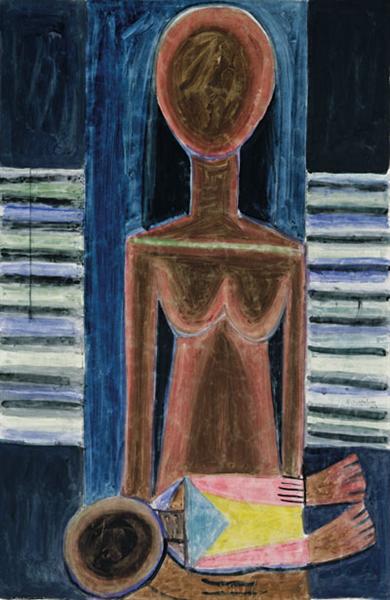
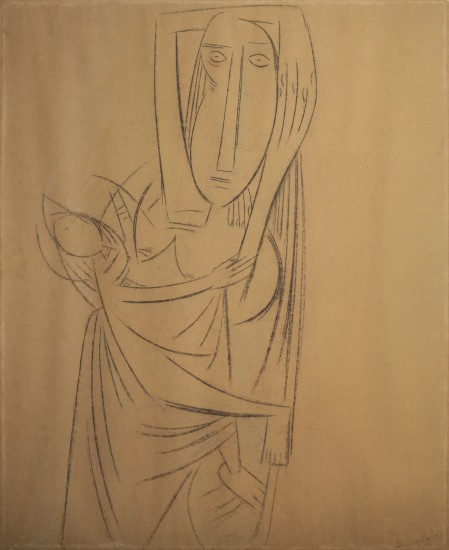
1957
Critiques
“He did not stop painting the fantastic until his death, in Paris, in 1982. His art is the last tarot of surrealism and a tropical wonder of modern painting.”
Jonathan Jones The Guardian
Septtemebr 13, 2016
“The fact is that, more positively than many of his fellow abstractionists, Lam evokes unequivocal emotions, but everything else be as it may, Lam utilizes his symbols as units in the interest of design.”
Geri Trotta ARTnews
November 20, 2015
“I found myself addressing painting after painting with exasperated questioning: what are you going to do with that shape?”
Matthew Collins Go London
September 13, 2016
“The Jungle is both enigmatic and enchanting, and has inspirired generations of viewers to liberate their imaginations.”
Max Fouchet Smarthistory
Winter 1988
Conclusion
This Cuban-born artist used his references to modern Afro-Cuban imagery to invoke thought on themes of social justice, the rebirth of the soul, and spirituality. With his heritage of his father being a Chinese immigrant and his mother is the descendant of African slaves and Spanish conquistadors, Lam draws from his background in companion with his education of European modernism to create the large scale paintings he is most known for. He used his work to challenge assumptions commonly made at the time in regards to non-European artwork, while also uncovering the effects of colonialism in the world of art.
Lam used his childhood, life experiences, travels, and relationships to build himself as an artist. He drew inspiration from different countries and people all over the world, but was still able to maintain his Afro-Cuban culture while expanding his artistic techniques and strategies.
Citations
Wifredo Lam: Biography. Cuban Artist. September 7, 2020.
https://www.britannica.com/biography/Wifredo-Lam
Jean-Louis Paudrat: Wilfredo Lam Biography.
www.wifredolam.net/en/biography.html
